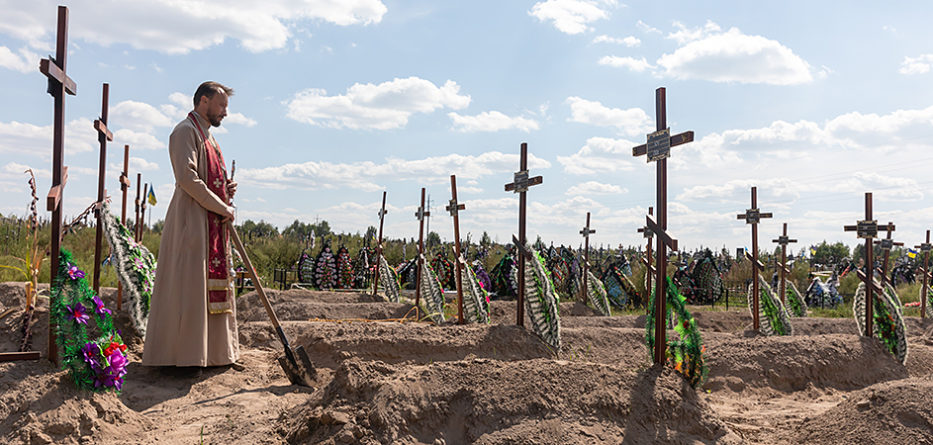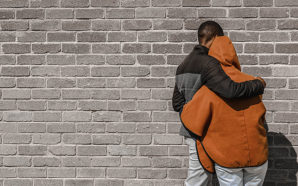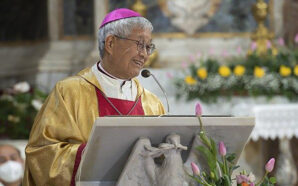Russia’s invasion of Ukraine and the West’s response to it are forcing the Catholic Church to discern anew how to witness to the Gospel demands of peace and justice
Communication problems are never just communication problems. And that is true also in the Church. Such is the case with Pope Francis and his recent interview with Swiss broadcaster RSI in which he used unclear words to call for peace in Ukraine. Recorded last month, though not due to be broadcast until March 20, this interview — during which the pope never even mentions Russia — represents something more than a media blunder. Yes, Francis should give fewer interviews and not be casual in his language on incredibly delicate and complicated issues like the wars currently waging in Ukraine and Gaza.
But there is something deeper here, and it has to do with “the signs of our times”. The Second Vatican Council (1962-65) stated that “the Church has always had the duty of examining the signs of the times and of interpreting them in the light of the Gospel” (Gaudium et spes, 4). The council took place sixty years ago, nearly twenty years after the end of World War II and right in the middle of the Cold War. The expression “the signs of our times” referred to a number of things: a new sense of awareness of the role of the Church in history; the betterment of the working class; the new social role of women; the formation of an international conscience; the liberation from colonialism; and, especially, the fact that Christians had learned something from the deals with Fascism and Nazism in the first half of the century. There was the sense that humanity was taking a step forward.
The Church and major world events
But today, in the 21st century, the notion of the signs of the times is more complicated. There are some positive signs: the acknowledgment of that women must be given a greater role, not only in society, but also in the Church; a new understanding of homosexuality; and the Anthropocene in the urgent run to protect creation. These are signs on which the global Church does not have a unified voice, and yet there is a horizon in front of us.
But there are even deeper difficulties in dealing with our historical times. The “duty of examining the signs of the times” means looking at long-term changes in our culture that cannot be pinpointed on one singular moment. It also means paying attention to major world events that say something about the trajectories we walk on as a community of individuals, as well a community of nations, countries, and international organizations. One of the signs of our times, and not one on which the Church is clear or unanimous, is the expansion of the post-World War II military alliance largely dominated by the United States known as NATO, the North Atlantic Treaty Organization. Since its establishment in 1949, NATO’s membership has increased from 12 to 32 countries over ten rounds of expansion. Sweden became the latest country to join the alliance on March 7 after Finland became a member in April of last year.
In defense of NATO’s expansion
In a recently published article in the eminent Jesuit periodical Theological Studies, US Catholic ethicist Gerald Beyer offers a synthetic but telling history of the Catholic Church’s assessment of NATO from the Cold War to the present. He makes a compellingly case why it is a moral duty for the West to expand the alliance in order to protect itself from the Russia of Vladimir Putin. Beyer argues that NATO’s existence and enlargement are justified in light of the right of nations to self-determination and legitimate defense according to the ethic of solidarity as understood in the Catholic social tradition. He further argues that NATO was not only justified to expand after the collapse of the Soviet Union in 1989, but that it should also be open to allowing Ukraine and the countries in the region to join the alliance in accordance with the above-noted tenets of Catholic social teaching.
The enlargement of NATO is one of the signs of the times because it is part of a larger picture that has unfolded since Russia’s invasion of Ukraine in February 2022 — namely, the re-armament of Europe (even in countries like Germany where this was a taboo after 1945) and the return of just-war doctrines (not just in the Church). There is also a wider historical context to be considered. Following Great Britain’s withdrawal from the European Union in 2016 (Brexit) there has been a temptation to “continentalize” Europe – not just by severing ties with its Western wing in the UK and the East with Russia, but also through the fortification of the southern border with the Mediterranean which is no longer a “mare nostrum”, but a buffer zone against the Middle East and a far more distant Africa.
The pope and the Ukrainian bishops: different points of view
What are the values that guide our ways of “examining the signs of the times” today? Clearly there is a difference between Pope Francis’ call for disarmament as “a moral duty“, which he stated during his March 3 Angelus address, and the message on war and a just peace that the Synod of Bishops of the Ukrainian Greek Catholic Church (UGCC) issued almost a month earlier. Titled “Rescue the oppressed from the hand of the oppressor”, the message was approved during the96th session of the Synod, which was held February 7–8 in Lviv. One sees a stark contrast between the pope’s view of the war in Ukraine and the admonition coming from the UGCC.
“In order to achieve a fictional peace, pacifists are often willing — consciously or unconsciously — to withdraw the perpetrators of peace from responsibility. The arguments vary and sometimes are even highly moral, such as the desire to avoid further human losses. This is the argument that is often raised in the context of Russia’s large-scale aggression against Ukraine,” says UGCC message.
This palpable tension between the Vatican and the Catholics of Ukraine is not just a diplomatic or political problem. The question we all face now is where we can find a fuller expression for the gospel in our historical context, where we see the “signs of the times”. Is it by working towards a ceasefire and then forging peace through the renunciation of military means and the practice of “active nonviolence”? Or is it by defending the values of democracy, the self-determination of peoples, and respect for minorities by confronting militarily an aggressor like Putin who has never made a mystery of what he wants to make of Ukraine?
Whatever one thinks of these two options, it is clear that yawning gaps are opening before us: between a pope who has displayed a novel and unceremonious openness towards the media and to a Vatican that has a longstanding diplomatic tradition of working discreetly behind the scenes; between Francis’ worldview and the United States’ second Catholic president (who has the support of the leaders of Ukrainian Catholics also in the diaspora); between the “old world” views espoused by political leaders in Europe and North America and the very different perspectives embraced by the emerging Churches in the Global South.
A most urgent task
This is a problem for the geopolitics of Catholicism. Francis, who does not come from the “first world”, has buried a certain alignment that has existed the past several decades between the Vatican and the geopolitics of Catholicism in NATO countries where liberal-progressive Catholics are now facing the dilemma of what to do with Putin’s Russia. Catholics in Asia, Africa or Latin America have no such dilemma before them.
Something else also happened in the last two years. The pope’s approach to the Russian invasion of Ukraine has also indirectly reopened a discussion on the meaning, for those Catholics who take Vatican II seriously, of “examining the signs of the times and of interpreting them in the light of the Gospel”. This is not the usual rift between liberal and conservatives, pro-Vatican II versus anti-Vatican II Catholics. There are deep questions that the Council did not address. The post-conciliar theological and magisterial tradition, with the help of Francis, is still trying to find its way in tackling them. One such issue concerns the moral limits of self-defense in the age of nuclear warfare.
The most urgent task is to distinguish the prophetic, Gospel-like shift in Church teaching towards a Christianity engaged in peace-building from a certain kind of Catholic pacifism of the post-Vatican II period that was a post–Cold War reverie, the theological version of the “end of history”. But there was no end of history, and Francis has shifted the position of the Vatican on the geopolitical map. A new iron curtain has descended, and this time it passes right through St. Peter’s Square.
Reproduced with permission from La Croix International.








